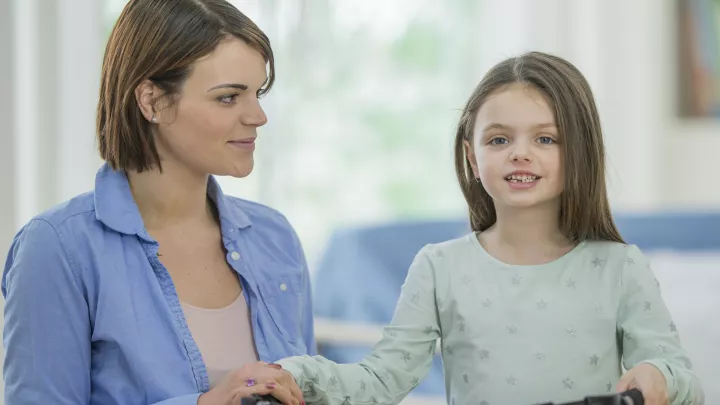Movement Disorder Treatments
Children’s Hospital Los Angeles is among the few places on the West Coast where pediatric-trained specialists work together to deliver expert assessment and treatment for movement disorders.
We can help your child get relief from spasticity, dystonia and otherrare movement disorders by providing specialized treatments to meet your child’s individual needs. We deliver personalized, ongoing care that enables your child and family to enjoy the best possible quality of life.
Children with movement disorders might experience:
- Muscle pain
- Muscle spasms or tightness
- Muscle weakness
- Difficulty balancing
- Loss of coordination
- Loss of motor control
- Uncontrolled movements such as tremors
- Speech problems
Treatment for Involuntary Muscle Movements
At Children’s Hospital, our expert neurologists offer a range of treatments for movement disorders, including:
- Oral medications
- Botulinum toxin injections
- Intrathecal baclofen pumps
- Deep brain stimulation assessment
- Selective dorsal rhizotomy assessment
- Referrals for Neurosurgery and Orthopaedic surgery
Oral Medications
Depending on your child’s movement disorder and symptoms, oral medications may be beneficial. We can prescribe medications that relieve symptoms of:
- Bradykinesia
- Chorea/chereoathetosis
- Dyskinesia
- Dystonia
- Myoclonus
- Rigidity
- Spasticity
- Tic disorders
- Tremor
If your child is prescribed an oral medication, the benefits typically outweigh the side effects or risks. However, your child’s health care provider will discuss the pros and cons of each medication with you and your child.
Botulinum Toxin Injections
If your child has increased muscle tightness due to spasticity or dystonia, or unusual muscle positioning or movements due to dystonia, botulinum toxin treatment may help. Botulinum toxins (such as Botox, Dysport, Myobloc or Xeomin) are medications given via injection into the muscle to help it relax.
These injections use small, targeted doses of medication to provide relief to specific muscles or muscle groups. There are typically minimal overall side effects. The effects of an injection last two to four months. Find out more about our Botulinum Toxin Clinic.
Intrathecal Baclofen Pumps
Baclofen is a medication that decreases spasticity (antispasmodic). If your child has severe spasticity or cannot tolerate oral medications, a baclofen pump may be a good treatment option. The pump sends medication directly to the spinal cord (called intrathecal delivery). This is often more effective than oral baclofen in relaxing the muscles.
This treatment involves a short surgery to implant the pump filled with intrathecal baclofen into the stomach area, and to place a small, flexible tube (catheter) into the space next to the spinal cord. The tubing is then connected to the pump. The baclofen in the pump can then be delivered through the tubing directly to the spinal cord. This is typically an outpatient procedure, and you go home the same day.
We adjust the amount of intrathecal baclofen each child receives and optimize treatment through follow-up visits to our Baclofen Pump Clinic.
Neurosurgery and Orthopedic Surgery
In some cases, neurosurgery or orthopedic surgery may be helpful in providing relief from spasticity or dystonia. Typically, neurologists first try less invasive treatments like oral medications or botulinum toxin injections. If these treatments don’t relieve symptoms, surgery may be recommended.
Surgical treatments for movement disorders include:
- Intrathecal baclofen pump
- Selective dorsal rhizotomy
- Orthopedic surgeries such as:
- Hip osteotomy and reconstruction, including varus derotation osteotomy (VDRO)
- Osteotomy of femur and tibia
- Muscle lengthening, including hip adductors, hamstrings and gastrocnemius
- Tendon lengthening (including Achilles tendon), release or transfer
- Foot reconstruction, including tendon transfer and osteotomy
- Guided growth, including hemiepiphysiodesis
Selective dorsal rhizotomy
Selective dorsal rhizotomy can be beneficial for some children with spastic cerebral palsy or spasticity in their legs due to other reasons. A neurosurgeon identifies and cuts some of the sensory nerve fibers that connect the muscle to the spinal cord. This decreases the abnormal signal coming from the muscle and decreases spasticity.
Children who receive selective dorsal rhizotomy cam benefit from:
- Decreased spasticity in their legs
- Improved motor function
- Enhanced participation in physical therapy
Collaboration Across Specialties
The specialists in the Movement Disorders Clinic work closely with additional subspecialists. This collaboration ensures that children have access to every treatment they need.
Your child’s treatment plan may also include care from experts from:
- Orthopedic Center
- Motion Analysis Lab
- Neurosurgery
- Occupational Therapy
- Physical Therapy
- Speech Therapy
- Nutrition
- Rehabilitation Program
Expert Movement Disorder Treatment
Patients who come to the Movement Disorders Clinic at Children’s Hospital Los Angeles can see every subspecialist they need in one convenient location. Learn more about the Movement Disorders Clinic.


